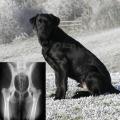Health Conditions
Articles that pertain to specific health issues/conditions in dogs - for example: orthopedic, cardiovascular, neurological, etc...
5 files
-
The genetics of eye disorders in the dog
By Ann Milligan
Mellersh Canine Genetics and Epidemiology 2014, 1:3
Source: https://cgejournal.biomedcentral.com/articles/10.1186/2052-6687-1-3
Abstract
"Inherited forms of eye disease are arguably the best described and best characterized of all inherited diseases in the dog, at both the clinical and molecular level and at the time of writing 29 different mutations have been documented in the scientific literature that are associated with an inherited ocular disorder in the dog. The dog has already played an important role in the identification of genes that are important for ocular development and function as well as emerging therapies for inherited blindness in humans. Similarities in disease phenotype and eye structure and function between dog and man, together with the increasingly sophisticated genetic tools that are available for the dog, mean that the dog is likely to play an ever increasing role in both our understanding of the normal functioning of the eye and in our ability to treat inherited eye disorders. This review summarises the mutations that have been associated with inherited eye disorders in the dog."
147 downloads
Submitted
-
Frequency of canine hip and elbow dysplasia decreasing in Finland
By Ann Milligan
ARTICLE: Frequency of canine hip and elbow dysplasia decreasing in Finland
Original source: The Finnish Kennel Club
http://www.kennelliitto.fi/en/news/frequency-of-canine-hip-and-elbow-dysplasia-decreasing-in-finland
Excerpt: "Genetic trends for hip and elbow dysplasia were assessed for the dogs born during the years 1993-2012. In hip dysplasia, the largest improvement can be seen in the Saint Bernard, the Smooth Collie, the Newfoundlander, the Beauceron and the Bordercollie. In elbow dysplasia, the Rottweiler and the St.Bernard have improved the most.
Genetic trends for hip and elbow dysplasia were assessed from the mean EBVs of the dogs born during the years 1993-2012. EBVs are being estimated for about 55 breeds in the Finnish Kennel Club, and these breeds were included in the assessment. Improvement in the mean EBVs was proportioned to the phenotypic screening results (Tables 1 and 3). A change of one point means that the breed average has moved one letter (hip dysplasia) or number (elbow dysplasia) to either a better or a worse direction."
295 downloads
Updated
-
Breeding Against Hip and Elbow Dysplasia in Dogs
By Ann Milligan
Katariina Mäki
Academic dissertation -- 2004
340 downloads
Submitted
-
Comparative analyses of genetic trends and prospects for selection against hip and elbow dysplasia in 15 UK dog breeds
By Ann Milligan
Authors: Thomas W Lewis, Sarah C Blott and John A Woolliams
excerpts from the abstract...
"This study aimed to both determine recent genetic trends in hip and elbow dysplasia, and evaluate the potential improvements in response to selection that publication of EBV for such diseases would provide, across a wide range of pure-bred dog breeds."
"EBV are shown to be both more accurate and abundant than phenotype, providing more reliable information on the genetic risk of disease for a greater proportion of the population. Because the accuracy ofselection is directly related to genetic progress, use of EBV can be expected to benefit selection for the improvement of canine health and welfare. Public availability of EBV for hip score for the fifteen breeds included inthis study will provide information on the genetic risk of disease in nearly a third of all dogs annually registered by the UK Kennel Club, with in excess of a quarter having an EBV for elbow score as well."
225 downloads
Updated
-
Monitoring Hip and Elbow Dysplasia Achieved Modest Genetic Improvement of 74 Dog Breeds over 40 Years in USA
By Ann Milligan
Authors: Yali Hou1,2., Yachun Wang1., Xuemei Lu2., Xu Zhang1, Qian Zhao3, Rory J. Todhunter4*, Zhiwu Zhang3,5*
Abstract...
"Hip (HD) and Elbow Dysplasia (ED) are two common complex developmental disorders of dogs. In order to decrease their prevalence and severity, the Orthopedic Foundation for Animals (OFA) has a voluntary registry of canine hip and elbow conformation certified by boarded radiologists. However, the voluntarily reports have been severely biased against exposing dogs with problems, especially at beginning period. Fluctuated by additional influential factors such as age, the published raw scores barely showed trends of improvement. In this study, we used multiple-trait mixed model to simultaneously adjust these factors and incorporate pedigree to derive Estimated Breeding Values (EBV). A total of 1,264,422 dogs from 74 breeds were evaluated for EBVs from 760,455 hip scores and 135,409 elbow scores. These EBVs have substantially recovered the reporting bias and the other influences. Clear and steady trends of genetic improvement were observed over the 40 years since 1970. The total genetic improvements were 16.4% and 1.1% of the phenotypic standard deviation for HD and ED, respectively. The incidences of dysplasia were 0.83% and 2.08%, and the heritabilities were estimated as 0.22 and 0.17 for hip and elbow scores, respectively. The genetic correlation between them was 0.12. We conclude that EBV is more effective than reporting raw phenotype. The weak genetic correlation suggested that selection based on hip scores would also slightly improve elbow scores but it is necessary to allocate effort toward improvement of elbow scores alone."
238 downloads
Updated
 Donate
Donate




